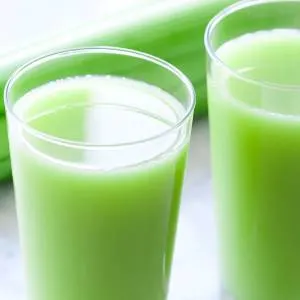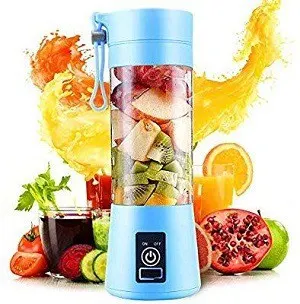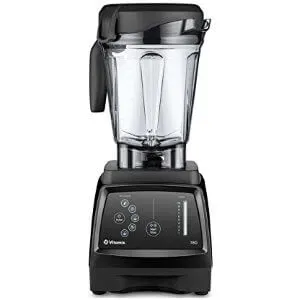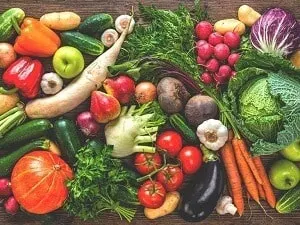 Juicing is a great lifestyle habit. Whether it is to boost your vitamin intake or enjoy the taste of freshly squeezed fruits and veggies, you can get your daily dose of juice even if you don’t have a juicer.
Juicing is a great lifestyle habit. Whether it is to boost your vitamin intake or enjoy the taste of freshly squeezed fruits and veggies, you can get your daily dose of juice even if you don’t have a juicer.
Learning how to juice without a juicer is not as hard as it may seem. It is also useful knowhow for people living with limited counter space in their kitchen, students who may be on a budget, or travelers craving their favorite juice.
If you have a blender instead, it can also give you juicing results as impressive as those of any juicer. You will need to pair it up with a spatula, fine mesh strainer, and a bowl that accommodates your strainer on top.
Read More: How to use a Ninja Blender for Juicing: Simple 5 Step Guide
Juicing with a blender instead
 If you own a powerful blender and love making smoothies and other drinks at home, you have probably wondered at some point if you can use it as a juicer. If you love smoothies and healthy beverages, chances are you love healthy juices as well. And so today I will answer the question, can blenders be used as juicers?
If you own a powerful blender and love making smoothies and other drinks at home, you have probably wondered at some point if you can use it as a juicer. If you love smoothies and healthy beverages, chances are you love healthy juices as well. And so today I will answer the question, can blenders be used as juicers?
The short answer is yes, you can certainly use your blender as a juicer. However, it is a lot more work. Your blender can obviously turn fruits and vegetables and other ingredients into liquids, but it is not the same type of liquid that you get when using a juicer. A juicer delivers watery fluid whereas a blender will make a thick paste more like a smoothie.
Also, a juicer is better at making juice from certain fruits and veggies, like cucumbers, celery, tomatoes, watermelon, and apples. A juicer can even be used to extract the juices from oranges, strawberries, and other hard fruits. But a juicer is not very good at making liquid from leafy ingredients like spinach or kale, and that is where a blender can come in handy.
Read More: Best Kale for Juicing: 5 Varieties & Kale Benefits
One of the tricks to making juice in a blender is cutting your vegetables into very small chunks. This will make it easier to extract the juices. Blenders are notorious for leaving chunks that you don’t get when using a juicer. But if you don’t mind chunks, a thicker juice, and extra nutrients, then by all means use a blender to juice your fruits and vegetables.
A blender is a versatile appliance that can handle a multitude of tasks including juicing. Some blenders even come with a special setting for juicing, but others that do not can work just as well.
The better models come equipped with powerful motors and blades capable of pulverizing all types of foods, even those that do not have high water content.
You’ll find that many blenders which feature a juicing option may also come with a selection of juice recipes designed to work with the blender.
Read More: How to blend without a blender
Can Blenders be Used as Juicers: Overview
The deal is simple. You will never make thin juice with a blender. It just doesn’t work the same as a juicer. But you can get a solid medium between Juice and a smoothie. With the right amount of liquid base, the appropriate fruits and vegetables, and a bit of patience, you can make what I would best describe as a watery smoothie.
And here is why it’s good for you. Obviously, fruits and vegetables are packed with fiber and other nutrients that are amazing for your health. This is why people love smoothies and it is also why people love juice. But using a blender is better for your health because all the ingredients are being broken up and shoveled into your body. When you do juicing, you miss out on a ton of nutrients.
This is because a juicer works like squeezing a piece of fruit in your fist and getting only the runoff, you are missing the majority of the nutrients and minerals that would otherwise improve your health. They are still trapped inside the leftover chunks of fruit. This is why a thick juice smoothie, or even a thin smoothie with a strong liquid base, is going to be better than anything made in a juicer.
Read More: 10 best liquids for smoothies
How to Juice with a Blender: the process
If you want to use a blender to make juice, there are a few simple things to keep in mind. First, you need to shake off the notion of what juice is. You are using a blender, and you are not going to get the same ultra-thin juice like out of a carton.
The first step is to have a strong blender. If your blender doesn’t have enough power, it is never going to be able to blend all the ingredients into a thin smoothie drink. I always recommend using a Vitamix blender or a Blendtec blender because of their strong motors and reliable blades.
Now that you have your blender, it is time to look at the ingredients. The most common juices are orange juice, apple juice, pineapple juice, and of course watermelon juice. If you want to make a straight juice in your blender, all you need to do is add the ingredients and blend on high speed for a long time.
You will also need to add a liquid base so that the blades can blend your ingredients properly and create a thinner liquid that more closely resembles juice. If you add two or three apples into a blender with a small pool of coconut water or regular water at the bottom, then blend until you have a very wet liquid, this is the closest you will get to in actual juice.
Related Articles:
 When using your blender for juicing, wash your ingredients and cut them into chunks. Citrus fruits should be peeled but there is no need to extract the seeds.
When using your blender for juicing, wash your ingredients and cut them into chunks. Citrus fruits should be peeled but there is no need to extract the seeds.
Others like carrots, beets, or apples do not need peeling but a good wash and scrub before placing in the blender.
The trick to successful juicing in a blender is to place the juicier items at the bottom. For instance, tomatoes, cucumbers, pears, grapes, or citrus fruits should go in first.
This should be topped with greens like kale or spinach followed by other sturdier ingredients.
Run your blender on the Juice setting or medium speed. If the mixture is too thick, stop and give the ingredients a good stir. Sometimes, you may also need to add in a little liquid such as water, juice, or more of the juicy ingredients. Pulse or puree again until everything is pulverized.
Once everything is blended, pour the mixture into a mesh strainer set over a bowl. Press on the mixture with a spatula to extract all the liquid and let it sit in place to allow any excess juice to drip out.
Pour your juice into a glass and enjoy.
Read More: How to make wheatgrass juice in a blender
The result
Making juice in a blender is more work than using a juicer. You not only need to cut your ingredients smaller than the larger chunks you would place in a juicer, but you will also get a thicker mixture that will need straining in most cases.
That being said, the thick liquid from the blender method preserves more fiber and nutrients, unless you strain it all out. This fiber-dense drink will be more satiating than strained juice and may even assist with digestion.
If you don’t have an upright blender, you could also use an immersion blender for juicing. However, this will only work nicely for softer and pulpier fruits and vegetables.
Tips and tricks to successful juicing
 Whether you use a juicer or blender to juice your ingredients, there are a few things to keep in mind regarding the taste and texture of your drink.
Whether you use a juicer or blender to juice your ingredients, there are a few things to keep in mind regarding the taste and texture of your drink.
Use ingredients with complementary flavors
To create a flavorful juice blend, select fruits and veggies that go well together in terms of taste. For instance, using something like pineapples, strawberries, and kiwi will give you a refreshingly tropical drink.
Or beets and carrots are perfectly complemented by adding in an apple.
Adding in melon, green apples, pears, or leafy greens gives you an invigorating green juice.
Use flavors that balance out your drink
To hit that sweet spot between sweet and savory, choose ingredients that balance the flavor.
For instance, when you prepare kale juice, you need other ingredients to minimize its bitterness. In this case, you could add in some pineapple or apple to insert some sweetness into the drink.
Or when you want to have a carrot or beet base for your drink, it’s a good idea to throw in a sweet-tasting fruit like apple to sweeten the blend. The same technique can follow when making a juice with a sour or tangy flavor.
On the other hand, if you have a sweet fruit such as pineapple as a base, you may want to balance that out by using some lemon juice with it.
If you like to spice up a bland beverage, do not hesitate to add some kick by including ginger in it.
Read More: 23 deliciously simple juice recipes
Always use water-based fruits and veggies
There should always be some ingredients that carry a lot of water, so your drink comes out smooth and uniform. Anything like watermelon, pineapple, tomato, or cucumber generates sufficient liquid during juicing to give the drink a smooth consistency.
But if none of your chosen ingredients are water-based, then add in some water to get things going.
Chop your ingredients uniformly
While you don’t have to be exceptionally precise, chopping up your fruits and veggies about the same size will make juicing with a blender much easier.
It will also give you a more uniform result instead of larger chunks still floating in the mixture. Occasionally stirring the ingredients may be required to get an even mix.
From Juice to Smoothie
If you want to pack more nutrients into your juice, I highly suggest using vegetables that have a high level of water content. When these are blended, they create a substance that is much more like juice. I am talking about things like cucumbers and celery, as these will pack your smoothie with nutrients while keeping it thin.
If you begin to add too many bulky ingredients you will be slipping from juice to smoothie. Things like avocado, banana, and other thick foods will undoubtedly give you a paste rather than a juice. If you want to stick with juice, try refraining from thick fruits and sticking to ingredients that have a lot of water already inside them. Melons are particularly good for making juice with.
Your base is going to be everything when dealing with a blender in place of a juicer. If you place a single banana in a blender and blend it, you are left with a gross mush. If you place one banana in your blender and fill the blender to its maximum capacity with coconut water, you now have a thin banana liquid that you could definitely call juice.
For liquid bases, you want to stay away from any dairy product or other type of natural milk. This rule applies only when you are using your blender for making juice. Almond milk and other thick ingredients are great for smoothies, but they will make your juice too thick.
For your liquid base, always stick to plain water or coconut water. You can also use juice to enhance the flavor of your homemade juice. A few squirts of orange juice from a carton when blending actual oranges to create more orange juice seems silly, but it actually works very well. The secret is to use thin liquids with very minimal viscosity.
How to juice without a juicer: final thoughts
A high-powered blender is a more versatile machine than a juicer. So, if you’re looking for ways on how to juice without a juicer, a sturdy blender may be your best bet.
It will give you the results you need but with a little extra effort.
Read More: The benefits of celery juice
